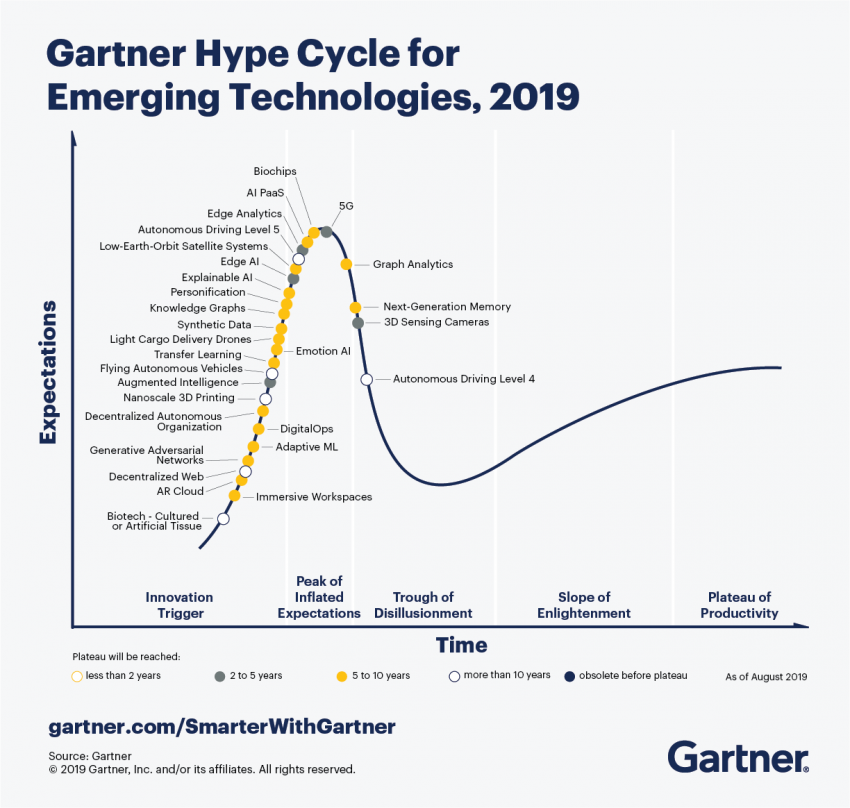It’s 2020, new technologies are emerging and the most hyped technologies of 2019 that failed have been set up to succeed this year.

We are amidst the 4th Industrial Revolution, and technology is evolving faster than ever.
Companies and individuals that don’t keep up with some of the major tech trends run the risk of being left behind.
Understanding the key trends will allow people and businesses to prepare and grasp the opportunities.
As a business and technology futurist, it is my job to look ahead and identify the most important trends. In this post, I give you the most hyped technologies and trends everyone should get ready for in 2020.
5G
Ah yes! More speed! We Need More Internet Speeds!
The 5th generation of mobile internet connectivity is going to give us super-fast download and upload speeds as well as more stable connections. While 5G mobile data networks became available for the first time in 2019, they were mostly still expensive and limited to functioning in confined areas or major cities eg China. 2020 is likely to be the year when 5G really starts to fly, with more affordable data plans as well as greatly improved coverage, meaning that everyone can join in the fun.
Safaricom was recently seen testing 5G thanks to Huawei. You can read more about this here: Safaricom Planning To Launch 5G

Super-fast data networks will not only give us the ability to stream movies and music at higher quality when we’re on the move. The greatly increased speeds mean that mobile networks will become more usable even than the wired networks running into our homes and businesses. Companies must consider the business implications of having super-fast and stable internet access anywhere. The increased bandwidth will enable machines, robots, and autonomous vehicles to collect and transfer more data than ever, leading to advances in the area of the Internet of Things (IoT) and smart machinery.
In 2018 we saw the first deployments of 5G for home and commercial use. Major telecomm and device companies have been preparing for inevitable full rollout of 5G and have been releasing and planning products around it. This is the time, according to Gartner, when early adopters will jump onto the 5G hype train. It remains to be seen however where 5G will find itself having the biggest impact
Both 5G and Wi-Fi 6 are built from the same foundation and will co-exist to support different use cases
WiFi6
Wi-Fi 6 is the next-generation wireless standard that’s faster than 802.11ac. More than speed, it will provide better performance in congested areas, from stadiums to your own device-packed home. It’s coming in 2019.
Wi-Fi 6 certification
began on September 16, 2019. That’s a big sign that hardware is on the way
! For example, Apple’s new iPhone 11
devices will support Wi-Fi 6 when they launch on September 20
Yes, Wi-Fi now has version numbers! Even those old confusing Wi-Fi standard names like “802.11ac” have been renamed to user-friendly names like “Wi-Fi 5.”
Here are the versions of Wi-Fi you’ll be seeing:
- Wi-Fi 4 is 802.11n, released in 2009.
- Wi-Fi 5 is 802.11ac, released in 2014.
- Wi-Fi 6 is the new version, also known as 802.11ax. It’s scheduled for release in 2019 but will see wide spread adoption in 2020.
8K Tech on Smartphones
While announcing its snapdragon 865 SoC chips, Qualcomm promises that the chip will enable smartphone cameras to record up to 8K videos. Since the chips will be released in the first quarter of 2020, it is likely that android phones manufacturers will rush to use the chip. Current Constraints however tell us that 8K isn’t really needed since average users cant differentiate between 8K and 4K. Let’s not forget the storage needs. But we hope this will be the basis for 8K VR and AR.

Autonomous Driving
While we still aren’t at the stage where we can expect to routinely travel in, or even see, autonomous vehicles in 2020, they will undoubtedly continue to generate a significant amount of excitement.
Tesla chief Elon Musk has said
he expects his company to create a truly “complete” autonomous vehicle by this year, and the number of vehicles capable of operating with a lesser degree of autonomy – such as automated braking and lane-changing – will become an increasingly common sight. In addition to this, other in-car systems not directly connected to driving, such as security and entertainment functions – will become increasingly automated and reliant on data capture and analytics. Google’s sister-company Waymo has just completed a trial of autonomous taxis in California, where it transported more than 6200 people in the first month
.
It won’t just be cars, of course – trucking and shipping are becoming more autonomous, and breakthroughs in this space are likely to continue to hit the headlines throughout 2020.

With the maturing of autonomous driving technology, we will also increasingly hear about the measures that will be taken by regulators, legislators, and authorities. Changes to laws, existing infrastructure, and social attitudes are all likely to be required before autonomous driving becomes a practical reality for most of us. During 2020, it’s likely we will start to see the debate around autonomous driving spread outside of the tech world, as more and more people come round to the idea that the question is not “if,” but “when,” it will become a reality.
Science fiction promised us we’d be living in a future of flying cars by now. So why shouldn’t we develop flying cars along side autonomous ones?
Cargo Delivery Drones
New sensor technologies and tracking technologies such as SLAM are making wheeled and flying drones better able to navigate obstacles and environments all of the time. Amazon is perhaps the most notable company experimenting with drone delivery. The company claims
it is only months away from launching pilot programs for drone delivery.
Of course cargo drones will take another year to finally reach Kenya but as a country let’s embrace manufacturing and it’s many forms eg Small Scale Home Manufacturing(Post coming soon on this). Over the decades we’ve seen Kenyans create Passenger Drones, hopefully we are not far from Jumia, KiliMall and other from delivering using drones.

Nanoscale 3D Printing
Though more than out 10 years from reaching its plateau of productivity, 3D printing at the nanoscale promises to create not only stronger structures, but also to potentially facilitate the development of new and interesting materials. Institutions such as ORNL
and LLNL
have been actively conducting research into new methods for 3D printing at the nanoscale.
Blockchain
Thanks to Bitcoin, everyone now knows about Blockchain. 2019 has been such a good year for Blockchain. People have developed products and services from this. But what exactly is Blockchain, you ask?
At its most basic level, blockchain is literally just a chain of blocks, but not in the traditional sense of those words. When we say the words “block” and “chain” in this context, we are actually talking about digital information (the “block”) stored in a public database (the “chain”).
“Blocks” on the blockchain are made up of digital pieces of information. Specifically, they have three parts:
- Blocks store information about transactions like the date, time, and dollar amount of your most recent purchase from Amazon. (NOTE: This Amazon example is for illustrative purchases; Amazon retail does not work on a blockchain principle)
- Blocks store information about who is participating in transactions. A block for your splurge purchase from Amazon would record your name along with Amazon.com, Inc. Instead of using your actual name, your purchase is recorded without any identifying information using a unique “digital signature,” sort of like a username.
- Blocks store information that distinguishes them from other blocks. Much like you and I have names to distinguish us from one another, each block stores a unique code called a “hash” that allows us to tell it apart from every other block. Let’s say you made your splurge purchase on Amazon, but while it’s in transit, you decide you just can’t resist and need a second one. Even though the details of your new transaction would look nearly identical to your earlier purchase, we can still tell the blocks apart because of their unique codes.
How Blockchain Works
When a block stores new data it is added to the blockchain. Blockchain, as its name suggests, consists of multiple blocks strung together. In order for a block to be added to the blockchain, however, four things must happen:
- A transaction must occur. Let’s continue with the example of your impulsive Amazon purchase. After hastily clicking through multiple checkout prompt, you go against your better judgment and make a purchase.
- That transaction must be verified. After making that purchase, your transaction must be verified. With other public records of information, like the Securities Exchange Commission, Wikipedia, or your local library, there’s someone in charge of vetting new data entries. With blockchain, however, that job is left up to a network of computers. When you make your purchase from Amazon, that network of computers rushes to check that your transaction happened in the way you said it did. That is, they confirm the details of the purchase, including the transaction’s time, dollar amount, and participants. (More on how this happens in a second.)
- That transaction must be stored in a block. After your transaction has been verified as accurate, it gets the green light. The transaction’s dollar amount, your digital signature, and Amazon’s digital signature are all stored in a block. There, the transaction will likely join hundreds, or thousands, of others like it.
- That block must be given a hash. Not unlike an angel earning its wings, once all of a block’s transactions have been verified, it must be given a unique, identifying code called a hash. The block is also given the hash of the most recent block added to the blockchain. Once hashed, the block can be added to the blockchain.
When that new block is added to the blockchain, it becomes publicly available for anyone to view—even you. If you take a look at Bitcoin’s blockchain
, you will see that you have access to transaction data, along with information about when (“Time”), where (“Height”), and by who (“Relayed By”) the block was added to the blockchain.
The blockchain ecosystem has evolved tremendously in the past two years. Although most people are unaware of the latest innovations, blockchain
keeps on evolving. The year 2020 seems very promising as major companies plan on releasing their blockchain services. This will bring blockchain in front of many, giving it more credibility and helping this tech thrive in the process.
Blockchain is driving the second major trend identified by Gartner. “Digitalized ecosystem technologies are making their way to the Hype Cycle fast,” Walker said. “
Blockchain
and IoT
platforms have crossed the peak by now, and we believe that they will reach maturity in the next five to ten years, with digital twins and knowledge graphs on their heels.”
As more and more IoT systems and products produce more and more data, it’s becoming increasingly important to not only manage and automate all of this data flow, but to keep it secure
as well. Blockchain offers great potential on both of these fronts for its high level of encryption as well as its ability to automate transactions via secure, verifiable “smart contracts.” “The shift from compartmentalized technical infrastructure to ecosystem-enabling platforms is laying the foundation for entirely new business models that are forming the bridge between humans and technology,” Walker said.
I will soon divulge deeper into this topic. So expect a blockchain article very soon.
AI for Everyone

The top identified trend by Gartner was “Democratized AI”—essentially, artificial intelligence made widely available. Advancements in robotics, cloud computing, AI Platform as a Service (PaaS), and of course autonomous driving are all driving this trend. According to Mike J. Walker, research vice president at Gartner, “Technologies representing democratized AI populate three out of five sections on the Hype Cycle, and some of them, such as deep neural nets and virtual assistants, will reach mainstream adoption in the next two to five years…Other emerging technologies of that category, such as smart robots or AI PaaS, are also moving rapidly through the Hype Cycle, approaching the peak, and will soon have crossed it.” No doubt the emergence of dedicated processors optimized for AI
applications, such as the Titan GPUs offered by Nvidia (shown), is playing a big role here.
Graphene Super/Ultra Capacitors, Processors, Batteries and More
We were promised that graphene could take out silicon from processors and break Moore’s law. We were promised thinner devices. We were promised faster processors. We were promised thin bullet proof clothing.
Before i get deep into this let me first tell you what this wonder material called graphene truly is.
Graphene (/ˈɡræfiːn/)
[1]
[2]
is an allotrope
of carbon
in the form of a single layer of atoms in a two-dimensional
hexagonal lattice
in which one atom forms each vertex
. It is the basic structural element of other allotropes, including graphite
, charcoal
, carbon nanotubes
and fullerenes
. It can also be considered as an indefinitely large aromatic
molecule, the ultimate case of the family of flat polycyclic aromatic hydrocarbons
. Play media
Graphene and its band structure
and Dirac Cones, effect of a grid on doping
Graphene has a special set of properties which set it apart from other allotropes of carbon. In proportion to its thickness, it is about 100 times stronger than the strongest steel. Yet its density is dramatically lower than any steel, with a surfacic mass of 0.763 mg per square meter. It conducts heat and electricity very efficiently and is nearly transparent.
[3]
Graphene also shows a large and nonlinear diamagnetism,
[4]
even greater than graphite, and can be levitated by Nd-Fe-B
magnets. Researchers have identified the bipolar transistor
effect, ballistic transport
of charges and large quantum oscillations
in the material.
[5]
Interestingly, when graphene is isolated from graphite it takes on some miraculous properties. It is a mere one-atom thick, the first two-dimensional material ever discovered. Despite this, graphene is also one of the strongest materials in the known universe. With a tensile strength of 130 GPa (gigapascals), it is more than 100 times stronger than steel.
Graphene’s incredible strength despite being so thin is already enough to make it amazing, however, its unique properties do not end there. It is also flexible, transparent, highly conductive, and seemingly impermeable to most gases and liquids. It almost seems as though there is no area in which graphene does not excel.
Potential applications
If graphene had merely one of its many superlative traits, it would be the subject of intense research into potential uses. Being so remarkable in so many ways, graphene has inspired scientists to think of a wide range of uses for the material, in fields as varied as consumer tech and environmental science.
Flexible electronics
In addition to its powerful electrical properties, graphene is also highly flexible and transparent. This makes it attractive for use in portable electronics. Smartphones and tablets could become much more durable using graphene, and perhaps could even be folded up like paper. Wearable electronic devices have been growing in popularity recently. With graphene, these devices could be made even more useful, designed to fit snugly around limbs and bending to accommodate various forms of exercise.
Graphene’s flexibility and microscopic width provide opportunities beyond mere consumer devices, however. It could also be useful in biomedical research. Small machines and sensors could be made with graphene, capable of moving easily and harmlessly through the human body, analyzing tissue or even delivering drugs to specific areas. Carbon is already a crucial ingredient in the human body; a little graphene added in might not hurt.
Solar cells/photovoltaics
Graphene is both highly conductive and transparent. As such, it has great potential as a material in solar cells. Typically, solar cells use silicon, which produces a charge when a photon hits the materials, knocking loose a free electron. Silicon only releases one electron per photon that hits it. Research has indicated that graphene can release multiple electrons for each photon that hits it. As such, graphene could be far better at converting solar energy. Before long, cheaper, more powerful graphene cells could produce a massive surge in renewable energy.
Graphene’s photovoltaic properties also mean that it could be used to develop better image sensors for devices such as cameras.
Semiconductors
![]()
Torsak Thammachote / Shutterstock
Due to its high conductivity, graphene could be used in semiconductors to greatly increase the speed at which information travels. Recently the Department of Energy conducted tests that demonstrated that semi-conductive polymers conduct electricity much faster when placed atop a layer of graphene than a layer of silicon. This holds true even if the polymer is thicker. A polymer 50-nanometers thick, when placed on top of a graphene layer, conducted a charge better than a 10-nanometer layer of the polymer. This flew in the face of previous wisdom which held that the thinner a polymer is, the better it can conduct charge.
The biggest obstacle to graphene’s use in electronics is its lack of a band gap, the gap between valence and conduction bands in a material that, when crossed, allows for a flow of electrical current. The band gap is what allows semi-conductive materials such as silicon to function as transistors; they can switch between insulating or conducting an electric current, depending on whether their electrons are pushed across the band gap or not.
Researchers have been testing a variety of methods to give graphene a band gap; if successful, that could lead to much faster electronics built with graphene.
Water filtration
A_Lesik / Shutterstock
Graphene’s tight atomic bonds make it impermeable for nearly all gasses and liquids. Curiously, water molecules are an exception. Because water can evaporate through graphene while most other gasses and liquids cannot, graphene could be an exceptional tool for filtration. Researchers at the University of Manchester tested graphene’s permeability with alcohol and were able to distill very strong samples of spirits, as only the water in the samples was able to pass through the graphene.
Of course, graphene’s use as a filter has potential beyond distilling stronger spirits. Graphene could also be immensely helpful in purifying water of toxins. In a study published by The Royal Society of Chemistry, researchers showed that oxidized graphene could even pull in radioactive materials such as uranium and plutonium present in water, leaving the liquid free of contaminants. The implications of this study are massive. Some of the biggest environmental hazards in history, including nuclear waste and chemical runoff, could be cleansed from water sources thanks to graphene.
As overpopulation continues to be one of the world’s most pressing environmental concerns, maintaining clean water supplies will only become more important. Indeed, water scarcity afflicts more than a billion people worldwide, a number that will only continue to rise given current trends. Graphene filters have immense potential to improve water purification, increasing the amount of fresh water available. In fact, Lockheed Martin recently developed a graphene filter called “Perforene,” which the company claims could revolutionize the desalination process.
Current desalination plants use a method called reverse osmosis to filter salt out of seawater. Reverse osmosis uses pressure to move water through a membrane. In order to produce large amounts of drinkable water, the pressure involved requires enormous amounts of energy. A Lockheed Martin engineer claims
their Perforene filters could reduce the energy requirements a hundred times less than that of other filters.
Filtration is one of graphene’s most obvious uses, and MIT engineers have made great strides in perfecting graphene’s ability to separate molecules. In 2018
, a team at MIT came up with a method to create tiny, “pinprick” holes in sheets of graphene. MIT’s researchers use a “roll-to-roll” approach to produce graphene. Their setup involves two spools: One spool feeds a sheet of copper into a furnace where it is heated to the appropriate temperature, then the engineers add methane and hydrogen gas, which essentially causes pools of graphene to form. The graphene film exits the furnace, winding onto the second spool.
In theory, this process allows for large sheets of graphene to be formed in a relatively short amount of time, which is crucial for commercial applications. Researchers had to fine-tune the process to get the graphene to form perfectly, and interestingly, the imperfect attempts along the way proved useful later on. As the MIT team tried to create pores in graphene, they started by using oxygen plasma to carve them out. As this process proved time-consuming, they wanted something faster and looked to their previous experiments for solutions. By lowering the temperature during the graphene’s growth, they got pores to appear. What appeared as defects during the development process ended up being a useful way to create porous graphene.
Superconductivity
Not long after scientists at Cambridge demonstrated
that graphene can act as a superconductor (a material with no electrical resistance) when paired with praseodymium cerium copper oxide, researchers at MIT discovered
another astounding property: It can apparently function as a superconductor alone, in the right configuration. The researchers stacked two slices of graphene, but offset them by an angle of 1.1 degrees. According to a report published in Nature, “Physicist Pablo Jarillo-Herrero at the Massachusetts Institute of Technology (MIT) in Cambridge and his team weren’t looking for superconductivity when they set up their experiment. Instead, they were exploring how the orientation dubbed the magic angle might affect graphene.”
So let’s hope that this year will be graphene’s year.
That’s it for today guys. Hope you’ve learned something. New Theme so kindly share your thoughts in the comment section and have a good day. I will update this as we proceed into 2020
Wait! before you go. I am selling advertising spaces. So be sure to email me if you want one. My Email
See Also
Source link













Leave a Reply